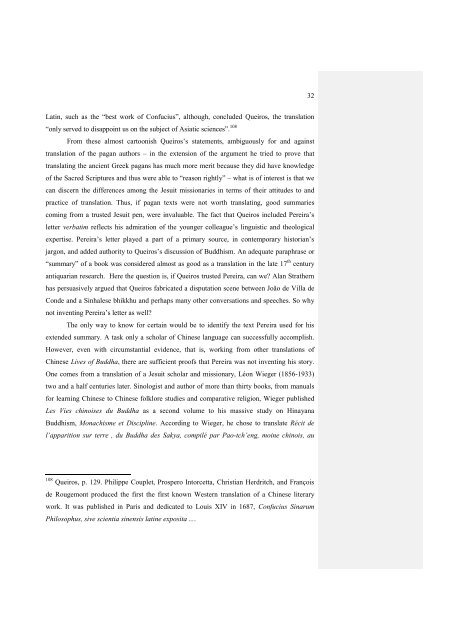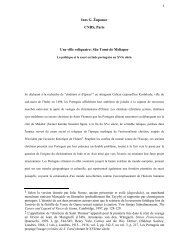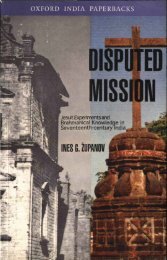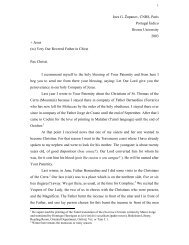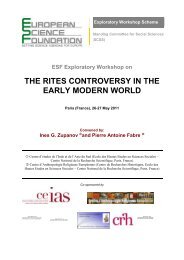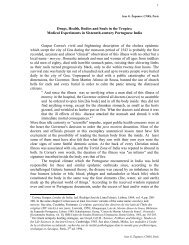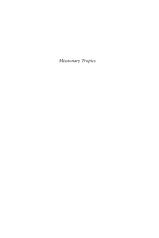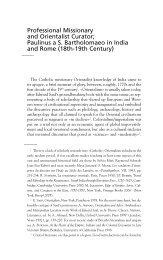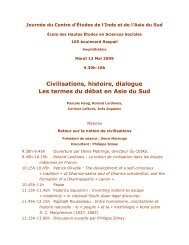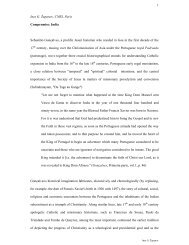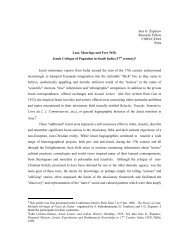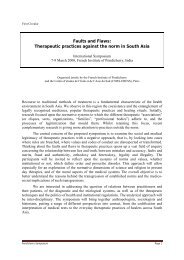Jesuit Orientalism; - Ines G. Županov
Jesuit Orientalism; - Ines G. Županov
Jesuit Orientalism; - Ines G. Županov
You also want an ePaper? Increase the reach of your titles
YUMPU automatically turns print PDFs into web optimized ePapers that Google loves.
32<br />
Latin, such as the “best work of Confucius”, although, concluded Queiros, the translation<br />
“only served to disappoint us on the subject of Asiatic sciences”. 108<br />
From these almost cartoonish Queiros‟s statements, ambiguously for and against<br />
translation of the pagan authors – in the extension of the argument he tried to prove that<br />
translating the ancient Greek pagans has much more merit because they did have knowledge<br />
of the Sacred Scriptures and thus were able to “reason rightly” – what is of interest is that we<br />
can discern the differences among the <strong>Jesuit</strong> missionaries in terms of their attitudes to and<br />
practice of translation. Thus, if pagan texts were not worth translating, good summaries<br />
coming from a trusted <strong>Jesuit</strong> pen, were invaluable. The fact that Queiros included Pereira‟s<br />
letter verbatim reflects his admiration of the younger colleague‟s linguistic and theological<br />
expertise. Pereira‟s letter played a part of a primary source, in contemporary historian‟s<br />
jargon, and added authority to Queiros‟s discussion of Buddhism. An adequate paraphrase or<br />
“summary” of a book was considered almost as good as a translation in the late 17 th century<br />
antiquarian research. Here the question is, if Queiros trusted Pereira, can we? Alan Strathern<br />
has persuasively argued that Queiros fabricated a disputation scene between João de Villa de<br />
Conde and a Sinhalese bhikkhu and perhaps many other conversations and speeches. So why<br />
not inventing Pereira‟s letter as well?<br />
The only way to know for certain would be to identify the text Pereira used for his<br />
extended summary. A task only a scholar of Chinese language can successfully accomplish.<br />
However, even with circumstantial evidence, that is, working from other translations of<br />
Chinese Lives of Buddha, there are sufficient proofs that Pereira was not inventing his story.<br />
One comes from a translation of a <strong>Jesuit</strong> scholar and missionary, Léon Wieger (1856-1933)<br />
two and a half centuries later. Sinologist and author of more than thirty books, from manuals<br />
for learning Chinese to Chinese folklore studies and comparative religion, Wieger published<br />
Les Vies chinoises du Buddha as a second volume to his massive study on Hinayana<br />
Buddhism, Monachisme et Discipline. According to Wieger, he chose to translate Récit de<br />
l‟apparition sur terre , du Buddha des Sakya, compilé par Pao-tch‟eng, moine chinois, au<br />
108 Queiros, p. 129. Philippe Couplet, Prospero Intorcetta, Christian Herdritch, and François<br />
de Rougemont produced the first the first known Western translation of a Chinese literary<br />
work. It was published in Paris and dedicated to Louis XIV in 1687, Confucius Sinarum<br />
Philosophus, sive scientia sinensis latine exposita ....


